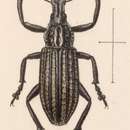Description
provided by INOTAXA archive
The depressed portions of the upper surface sparsely clothed with intermixed cinereous and bluish-green scales; the elytral interstices 1 (sutural), 3, 5, and 7 broadly, and the others narrowly and feebly costate.
- license
- cc-by-3.0
- copyright
- Biologia Centrali-Americana
Distribution
provided by INOTAXA archive
Hab.MEXICO, Puebla (Sallé), Amecameca (Höge).
- license
- cc-by-3.0
- copyright
- Biologia Centrali-Americana
Distribution
provided by INOTAXA archive
Hab.MEXICO, "Sierra de Durango" (ex Flohr).
- license
- cc-by-3.0
- copyright
- Biologia Centrali-Americana
Latin Diagnosis
provided by INOTAXA archive
Elongatus, elytris interstitiis 3°, 5°, 7° elevatis, integris, plumbeo-nitentibus, intervallis dense squamosis; rostro medio canaliculato.
Long. 18—19 millim.
- license
- cc-by-3.0
- copyright
- Biologia Centrali-Americana
Physical description
provided by INOTAXA archive
E. costatus is the most elegant species of this group, and it can be very easily identified by the great development of the alternate elytral interstices, and the diminution of the sculpture between them—it thus results that the second, fourth, and sixth interstices cannot be recognized at all. The rostrum is rather longer than usual, considerably widened in front, and very distinctly but not broadly sulcate along the middle. The thorax has a shallow longitudinal median sulcus, which is slightly interrupted about the middle; outside this is an irregular, comparatively smooth space; the lateral part of the surface is very coarsely though not deeply rugose. The costæ on the wing-cases are remarkably definite, and contrast strongly with the spaces between them, which are densely covered with very minute, pallid (in the typical form white) scales. The legs are only feebly squamose. The swelling or incrassation of the front tibia at the tip of its posterior face is more developed in this than in any other species of the genus. The female is much broader than the male.
The three specimens from Sallé's collection I treat as the typical form of the species; they have the scales in the grooves of the elytra almost white, while in the two examples from Amecameca they are pale brown.
- license
- cc-by-3.0
- copyright
- Biologia Centrali-Americana
Physical description
provided by INOTAXA archive
Var. The depressed portions of the upper surface sparsely clothed with intermixed cinereous and bluish-green scales; the elytral interstices 1 (sutural), 3, 5, and 7 broadly, and the others narrowly and feebly costate.
- license
- cc-by-3.0
- copyright
- Biologia Centrali-Americana

